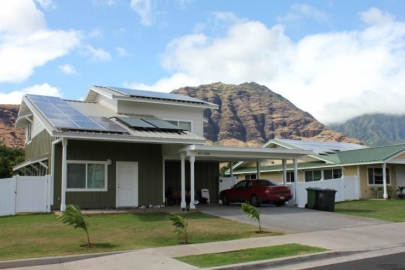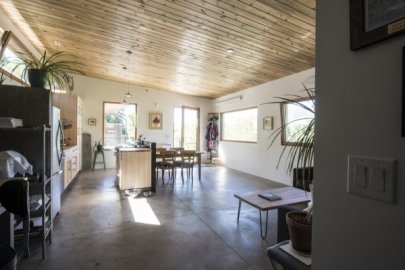There are many types of roof systems available, but the surface solar reflectance of the roofing product—the outermost layer of the roof exposed to the sun is, also known as the roof covering—determines whether the roof is cool or not. There are cool options for nearly all types of roof coverings.
Paths to a Cool Roof
Cool roofing products usually cost no more than comparable conventional roofing products. The easiest and least expensive way to make your roof cool is to choose a cool covering during new construction, or when your existing roofing covering needs to be replaced. Certain types of roofing products can also be retrofitted with cool coatings, but this will incur extra material and labor costs.
Color Choice
White roofing products stay coolest in the sun, reflecting about 60 – 90% of sunlight. However, since about half of sunlight arrives as invisible “near infrared” radiation, we can boost the solar reflectance of dark materials by using special pigments (colorants) that preferentially reflect this invisible light. Such “cool colored” products typically reflect about 30 – 60% of sunlight, staying cooler than conventionally colored products (though not as cool as white).
Products for Steep Roofs (Pitch > 2:12)
Asphalt shingles are composed of a fiberglass web coated with filled asphalt, or filled modified asphalt, which has been surfaced with colored ceramic-coated rock. Successive rows of shingles are overlapped. This helps the roof shed water while permitting the shingles to “breathe” (release underlying moisture).
Cool option: Choose an asphalt shingle that is surfaced with light-colored or (if a darker color is preferred) cool-colored granules. Field-coating previously installed asphalt shingles roofs to make them cool can create moisture retention issues, may void the shingle manufacturer’s warranty, and is not recommended.
Wood shingles (machine sawn) and wood shakes (hand split) are pieces of wood that are overlapped to cover the roof types..
Cool option: Wood shingles and shakes are naturally “cool colored” materials.
Polymer shingles (also known as synthetic or composite shingles) are formed of polymer shaped to resemble asphalt shingles, wood shingles, wood shakes, slate, clay tiles, or concrete tiles. They are overlapped to cover the roof.
Cool option: Choose a polymer shingle that is factory-colored with light- or cool-colored pigments.
Clay tiles can be unglazed (terra cotta), or glazed to increase water resistance and provide choice of color.
Cool options: Choose a terra cotta clay tile (typically a natural cool color) or a clay tile with a factory-fired light- or cool-colored glaze. Glazed clay tiles can also be retrofit with a field-applied light- or cool-colored polymer coating that is applied when the tiles are installed.
Concrete tiles are typically formed from gray-cement concrete. They can be integrally colored with pigments, or surface colored with a slurry coating (pigment + white cement) or with a pigmented polymer coating.
Cool options: Choose a concrete tile with a factory-applied light or cool-colored slurry or polymer coating. Concrete tiles can also be retrofitted with a field-applied light- or cool-colored polymer coating.
Slate tiles are split from slate (metamorphic rock) and overlapped to cover the roof.
Cool options: Slate tiles are not usually cool.
Metal shingles or tiles are metal pieces, often shaped to resemble asphalt shingles, clay tiles, wood shingles, or concrete tiles, that are overlapped to cover the roof. They can be unpainted, factory painted, or factory surfaced with mineral granules.
Cool options: Choose a metal shingle or tile that is factory coated with a light- or cool-colored paint, or factory surfaced with reflective mineral granules. Unpainted metals are typically good solar reflectors but poor thermal emitters, and get hotter in the sun than painted metals of comparable solar reflectance; they are not the best choice. Metal shingles or tiles can be retrofitted with a field-applied paint, but an oven-baked factory-applied paint is more durable and economical than a field-applied paint.
Products for Low -Sloped Roofs (Pitch ≤ 2:12)
Single-ply membranes are prefabricated sheets rolled onto the roof and attached with mechanical fasteners, adhered with chemical adhesives, thermally welded, or held in place with ballast (heavy substances such as gravel, stones, or pavers).
Cool option: Choose a membrane that is factory-colored with light- or cool-colored pigments or light-colored ballast.
Built-up roofs consist of a base sheet, fabric reinforcement layers, and a surface layer.
How they can be made cool: The surface layer can be made different ways,—typically a cap sheet or ballast—to protect the lower layers from wind and weather. (A cap sheet is typically a fiberglass web coated in asphalt, or a modified bitumen sheet membrane, and is often surfaced with mineral granules.)
Cool options:
- Choose a cap sheet with a factory-applied reflective mineral surface or reflective coating
- Substitute reflective marble chips or gray slag for dark gravel in a flood coat of asphalt
- Field-apply a reflective coating
Modified bitumen sheet membranes have one or more layers of plastic or rubber material with reinforcing fabrics, and are surfaced with mineral granules or a smooth finish. These can also be used to surface a built-up roof, producing a "hybrid" roof.
Cool options: Choose a cap sheet with a factory-applied reflective mineral surface or reflective coating.
Spray polyurethane foam roofs are constructed by mixing two liquid chemicals together that react and expand to form one solid piece that adheres to the roof. Foams are highly susceptible to mechanical, moisture, and UV damage, and rely on a protective coating.
How they can be made cool/Cool option: The protective coatings are usually already reflective and offer cool roof performance.
Products for Steep and Low-sloped Roofs
Standing-seam metal roofs are formed by joining metal panels with elevated vertical seams; the joined panels cover the roof. They can be unpainted, factory painted, or factory surfaced with mineral granules.
Cool options: See “metal shingles or tiles”.
Green (Vegetative) Roofs
You may also consider installing a green roof., which refers to the presence of vegetation rather than the color. Green roofs are ideal for urban buildings with low-sloped or shallow-pit roofs, and can include anything from basic plant cover (extensive vegetative roof) to a garden. or even small trees (intensive vegetative roof). The primary reasons for using this type of roof include managing storm water and creating an attractive and enjoyable rooftop open space.
Green roofs are “inverted” roofs, meaning that the waterproofing membrane is located beneath the plants and most of the roof components. In that location the membrane is well protected from the sun’s degrading UV radiation, but leaks are also much more challenging to find and difficult to repair. Green roofs are considerably heavier and more expensive to construct and maintain than non-vegetated roofs. The underlying structure needs to be able to bear the additional load and the plant cover typically requires some maintenance. You should carefully assess your property, building structure, local climate, and consult professionals before deciding to install a green roof.
Green roofs are cooled primarily by the evaporation of water from plant surfaces rather than by reflection of sunlight. The soil layer also provides additional insulation as well as thermal mass.
Deciding Whether and When to Install a Cool Roof
When deciding whether to install a cool roof, you’ll need to determine whether the energy savings and other benefits will justify the cost premium (if any). How much energy you will save depends on several factors such as your home's climate and surroundings, the extent to which the roof assembly is insulated, the type of roof you have, and the efficiency of your heating and cooling system.
If you are building a new home, you can decide during the planning phase what type of roof to install and whether it should be a cool roof. If you want to convert an existing roof into a cool roof, you have three basic options:
- Install a cool roofing product when your existing roof
- Install a cool roofing product before your existing roof reaches the end of its service life (could be wasteful)
- Apply a cool roof coating to the existing roof, if the type of roof is suitable for coating
Cost and Energy Savings
A cool roof does not necessarily cost more than a non-cool roof, especially if you are installing a new roof or replacing an existing one. However, converting a standard roof that's in good condition into a cool roof can be expensive.
Climate and Environment
Your climate is an important consideration when deciding whether to install a cool roof. Cool roofs achieve the greatest cooling savings in hot climates, but can increase energy costs in colder climates if the annual heating penalty exceeds the annual cooling savings.
Moisture Control
In warm, moist locations, where roofs are subject to algae or mold growth, dark growths may be more visible on light-colored roofs than on dark roofs. Some roof coatings include special chemicals that prevent mold or algae growth for a few years.
In cold climates, roofs can accumulate moisture through condensation, and it is possible that cool roofs might be more susceptible to accumulating moisture than dark roofs of the same design. Condensation can be avoided using proper design techniques.
Finding Cool Roofing Products
Cool roof qualifications, such as minimum values of solar reflectance and thermal emittance, vary by standard or program, location, building type, and roof slope. Therefore, there is no single definition of a cool roof. However, the Rated Products Directory of the Cool Roof Rating Council reports the solar reflectance and thermal emittance of thousands of roofing products.





